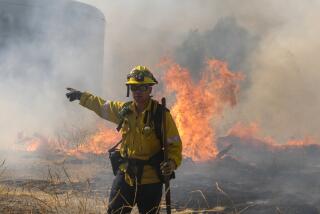Insurers See No Rerun of ’03 Fires
Wildfires that burned thousands of homes in California last year were the most expensive in history for the insurance industry, and another bad fire season is predicted this year in much of the West.
But most of the nation’s insurers haven’t raised rates or required forest-dwelling homeowners to take steps to protect their homes. Instead, the industry is largely hoping that last year’s fires, which also burned hundreds of homes in Arizona and Colorado, were a fluke.
“It was an anomaly of sort,” said Bill Mellander, spokesman for Allstate Corp., of the California fires. “A fire event of that size you think is not going to be an everyday event.”
In California, insurers processed more than 19,000 claims and paid out $2.04 billion in damages from October’s Cedar and Old fires, according to Insurance Services Office Inc. That price tag was equivalent to almost half of all the premiums collected in California in 2002.
The two fires combined were the most expensive ever, although the 1991 Oakland Hills fire in California ranks as the most costly single fire at $1.7 billion, according to Insurance Services Office, a provider of insurance information.
Another bad fire season is expected this year, with dry conditions in Southern California, southwest Arizona, New Mexico, Washington state and Oregon making them susceptible, said Rick Ochoa, national fire weather program manager for the Bureau of Land Management in Boise, Idaho.
“I think it’s going to be worse this year in the Northwest,” he said. “This year we’re seeing larger areas of dryness.”
Insurance firms are paying attention to the forecasts, and they are encouraging homeowners to clear brush, trim trees, remove firewood and re-evaluate roofs. Most insurers are not making those steps a requirement of coverage, but some are.
State Farm Insurance Cos. last year began requiring 24,000 homeowners in fire-prone areas of six Western states -- Arizona, Colorado, Nevada, New Mexico, Utah and Wyoming -- to fix hazards on their property. The move was prompted by drier conditions and wildfires like the 2002 Hayman fire in Colorado that destroyed 133 homes.
Policies could be dropped if homeowners do not cooperate.
So far, the response has been good, with the majority of homeowners cooperating, said Maria Taylor, spokeswoman for State Farm.
“I think it protects everybody,” she said.
Colorado Farm Bureau Mutual Insurance Co. has always required homeowners in fire-prone areas to clear brush around their homes, said Bill Benedetti, underwriting vice president.
“We do have a heightened awareness to it, but it’s nothing different than what we’ve been doing,” he said. The insurer has about 1% of the Colorado market.
Diane and John Benge of Woodland Park, Colo., who lost their cabin to the 2002 Hayman fire, were required by the insurer to clear trees within 30 feet of their new house. The couple also got a discount for building a stucco and siding house with a metal roof.
“I think if you’re going to live in the forest, it’s probably a good idea for safety more than anything,” Diane Benge said.
Foresters have encouraged insurers for years to require homeowners to clear brush and trees and to use fire-resistant building materials, especially on roofs. More companies are looking at requiring such practices, said Pete Moraga, spokesman for the Insurance Information Network of California. “If the homeowners haven’t kept up the clearance, there may be changes in the way that policy is drafted for the following year,” he said.
California Insurance Commissioner John Garamendi said he didn’t understand why more companies don’t require those precautions.
“It should be that way,” he said. “Some companies do it that way and other companies just look at maps and don’t bother looking at the house. They don’t have a clue where the house is or what the risks are.”
More to Read
Inside the business of entertainment
The Wide Shot brings you news, analysis and insights on everything from streaming wars to production — and what it all means for the future.
You may occasionally receive promotional content from the Los Angeles Times.










